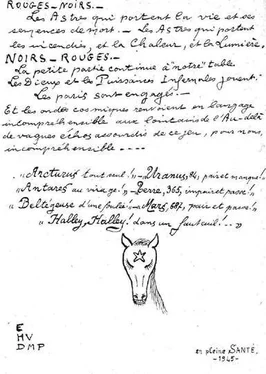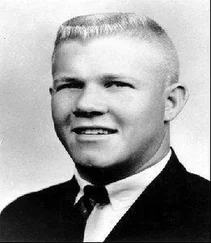Possibly to lure Petiot out of hiding, the French police handed over the dubious tale of Charles Rolland to the young journalist and Resistance fighter Jacques Yonnet. On September 19, 1944, Yonnet published an article in Résistance , one of the many underground papers that had emerged as popular dailies in post-Liberation Paris. After opening with a disclaimer that he could not vouch for the truth of the allegations, Yonnet proceeded to outline Rolland’s deposition in vivid detail. He titled the article: “Petiot, Soldier of the Reich.”
A few days later, there was a dramatic breakthrough in the investigation. A long, handwritten response signed by someone claiming to be Marcel Petiot arrived at the newspaper’s offices, forwarded by attorney René Floriot. To verify its authenticity, the police obtained a sample of the physician’s handwriting and asked leading graphologist Professor Edouard de Rougemont to study the two specimens. The letter, he concluded, was genuine, and Petiot’s full rebuttal was published on October 18, 1944.
“Dear Mr. Editor,” Petiot began. “All accused persons should be considered innocent until proven guilty.… Because of law and justice I have the right to defend myself and to ask you to print my answer.” Indignant and scornful of the article’s many errors, Petiot accused the police of inventing the absurd so-called Charles Rolland and then having the “sick imagination” to attribute such worthless claims to him.
As a longtime member of the Resistance, Petiot said, he had fought valiantly against the Nazis, only to be arrested, tortured by the Gestapo, and imprisoned for almost eight months. Many high-ranking members of the Resistance, including some now holding “public office,” he said, were trying to find a way to reveal the truth about his patriotic activities without exposing themselves to danger. Petiot outlined his alleged services to the Resistance, which had for so long been slandered by the German-controlled press.
His code name, Petiot admitted, was Dr. Eugène, and his code number was 46. He claimed to have served in the secret Resistance network called “Fly-Tox,” which had concentrated on attacking the Organization Todt and stealing secrets from German industry. With no less bravado, Petiot next discussed his “liquidations,” as he called them, insisting that they were always “Germans and collaborators and Gestapo agents.” It was outrageous, he said, to call him a soldier of the Reich. The letter concluded:
The author of these lines, far from having committed dishonorable acts, far from having forgiven his torturers and still further from having helped them, adopted a new pseudonym immediately after his release from the German prison [January 1944]. He has also retaken his place with the Resistance with [another] new pseudonym and asked for a more active role in order to avenge the hundreds and thousands of Frenchmen killed and tortured by the Nazis. He always remained in contact with his friends, and fought for the Liberation to the best of his abilities, despite the dangers that his action has caused him. He still contributes as much as possible to the Liberation, and apologizes if he cannot take the time to follow the polemic more closely
.
Still using the third person to describe his actions, Petiot concluded: “Having lost everything except his life, he is risking even that under a false name, scarcely hoping that tongues and pens now freed from their shackles will tell a truth so easy to guess, and forget the clumsy kraut lies that require only two sous of French common sense to see through.”
Understandably, the police were thrilled by this response. Not only did this letter confirm that Petiot was still alive—and many detectives had feared that the reports of his death might prove true—but it also provided many clues to his whereabouts. Petiot, in rushing to defend himself, had aided them far more than he realized.
In addition to admitting his identity as Dr. Eugène and claiming a specific code number, which could be verified, Petiot had volunteered that he was in fact working in the Resistance under a different name and provided them with no less than eight pages of his handwriting to discover his alias. He had not bothered to type his response or to ask his lawyer to do it for him. The envelope’s postmark showed that the letter had been mailed in Paris; the speed of Petiot’s rebuttal suggested that he might well still be in the capital.
At this point, many people helped track down the serial killer. An editor of Résistance , Louis Jean Finot, released Petiot’s letter and the police circulated it throughout the FFI. All indications suggested that Petiot was probably masquerading as a doctor, which would make sense as a cover for someone with his background, and so the search focused on physicians in the Resistance. Colonel Rol, leader of the FFI in Paris, secured samples of handwriting that resembled the letter in question.
Among a number of people assisting the investigation was Captain Henri-Jean Valeri, originally from the commune of Villepinte in Seine-et-Oise and the leader of an FFI counterespionage unit in charge of rooting out traitors and “collabos.” A slender man in his late forties, with dark brown hair and a thick mustache and beard, Valeri served as investigations officer for the intelligence organization G2 in the First Infantry Regiment of the FFI, stationed in the armory of Reuilly. Valeri had considerable skill and experience, and his quick promotion to captain—even for a time that saw many quick promotions—proved his zeal. Police investigators were more optimistic about the case than they had been in months, but they were quickly running out of time.
AFTER the Liberation, Frenchmen began the long and difficult process of coming to terms with the dark years of the Occupation. The first priority in the reckoning was to remove collaborators from positions of power. Sometimes this was done through the legal system in the High Court newly created to judge cases of treason, or “intelligence with the enemy.” Other times, it was action taken by people themselves in the form of lynchings, summary executions, or a wide range of vigilante-style punishments. Women accused of sleeping with the Germans, the so-called “horizontal collaboration,” in particular, were punished by the wrath of mobs.
An estimated ten to twenty thousand women would have their heads shaved, be stripped naked or semi-naked, and then marched through the streets, sometimes with swastikas tarred or tattooed on their breasts or with signs around their necks bearing the words “I whored with the Germans.” Some of them, being new mothers, carried babies in their arms. German authorities estimated that fifty to seventy-five thousand children had been born to German fathers and French mothers in the Occupation. A recent study by Jean-Paul Picaper and Ludwig Norz, Enfants Maudits (2004), raised the figure to about two hundred thousand.
The violent purging was more common in the south of France, where tensions between Resistance and Militia were more severe, and many places were liberated by the French Resistance rather than the Allies. But no town of any size was immune. In all, about 310,000 cases involving some 350,000 people charged with “intelligence with the enemy” were brought to court. About 60 percent of the cases were dismissed for lack of evidence. Of the 125,000 that went to trial, approximately 100,000 resulted in convictions, though almost half of them (49,723) received the verdict “national indignity,” which bore no prison sentence or fine. About 20 percent of the trials ended with a prison sentence (25,901), with another 13,339 sentenced to forced work. Officially, 7,055 people received death sentences, though the vast majority of these were not carried out.
Читать дальше












